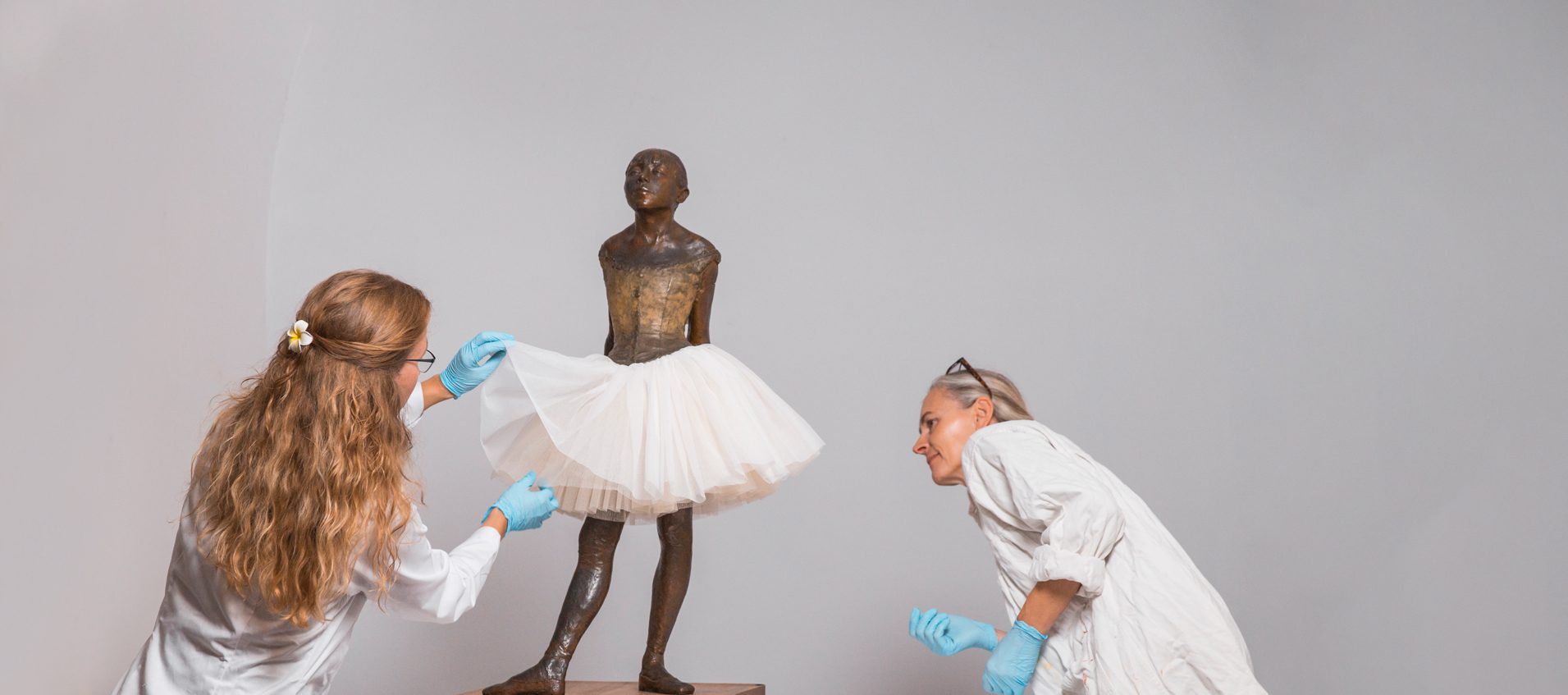Published October 18 2022
On 27 October, the Glyptotek opens this autumn’s special exhibition – The Art of Conserving a Masterpiece. The exhibition spotlights the craftsmanship and expert artistic research that goes into ensuring that art can be preserved for posterity. The works in the exhibition have all passed through the loving hands of our conservators, and one of the museum’s most popular works has been given a particularly radical makeover.
The Art of Conserving a Masterpiece reunites visitors with one of the museum’s most popular works: Little Dancer Aged 14 (1881) by the French artist Edgar Degas. The ballerina has been given a new tutu and undergone a major transformation vis-à-vis how most of us remember the work. The exhibition also provides a rare insight into recently conserved drawings by important French artists, including Jean-Baptiste Carpeaux, Eugène Delacroix, Jean-François Millet, Honoré Daumier, Jean-Baptiste-Camille Corot and Paul Gauguin. The drawings are sensitive to light and therefore not normally available to the public. But now the Glyptotek is offering visitors a unique opportunity to see them for a short period of time.
All the works have been through the expert hands of a conservator. Conserving and safeguarding a masterpiece is not always an easy task. The exhibition looks at the work of a conservator, concentrating on how they assess the condition of a work, formulate a diagnosis and decide on the necessary treatment.
A visit to the conservator’s workshop
Little Dancer Aged 14 has been part of the Glyptotek’s French collection since 1949. Degas’ bronze sculpture was cast after the artist’s death and probably wore the original tutu from the 1920s. The tutu underwent conservatorial processing in 1979. However, recently Rebecca Hast, the Glyptotek’s conservator, saw that the faded dark-brown tutu that encircles the waist of Little Dancer Aged 14 was worn down and in such poor condition that it was disintegrating. What the dancer needed was radical conservation.
“It’s an exciting, yet tricky task. There are about 25 versions of Edgar Degas’ bronze sculpture in various museums and private collections around the world. If you compare the skirts, they are all very different. The Metropolitan Museum of Art created one version of the tutu when they had to conserve it. The Musée d’Orsay created another one,” explains Rebecca Hast, the Glyptotek’s conservator.
Christine Horwitz Tommerup, the Glyptotek’s Curator of French and Danish Art, continues: “Degas left no records of what he wanted the tutu to look like. The Glyptotek chose to reconstruct the tutu based on what we know about the look of the original 1881 tutu. Recent research has revealed how detailed the tutu was: hand-sewn fabric in various layers, and several layers of hand-cut, V-shaped tulle.”
A controversial dancer
The first time the world was introduced to Edgar Degas’ Little Dancer Aged 14 was at an Impressionist exhibition in Paris in 1881. This version was in painted wax, featuring a copious white ballet tutu. The hair was real, there were creases in the stockings, and knees were visible under a very detailed tutu.
Radical in its expression and form, Degas’ original sculpture of the ballerina Marie Van Goethem caused a huge scandal when exhibited. The way in which Degas mixed different materials was regarded as controversial, and people found the dancer both ugly and repulsive. The new tutu is based on the history of the sculpture and emphasises its contrasts: the realistic features of the ballerina’s face in contrast to the white, elaborate tutu.
About the exhibition
The Art of Conserving a Masterpiece runs from 27 October 2022 to 31 January 2023, featuring not only the reconstruction of Edgar Degas’ Little Dancer Aged 14, but also 24 other French works from the 19th and 20th centuries in chalk, pencil, Indian ink, watercolour, gouache, tempera and pastel. On display for just a short period, the works include: sketches and studies for sculptures by Jean-Baptiste Carpeaux; small, intimate experiments on paper by the painters Eugène Delacroix, Jean-François Millet, Honoré Daumier and Jean-Baptiste-Camille Corot; Édouard Vuillard’s sophisticated interiors; and works by Armand Guillaumin, Alfred Sisley and Paul Gauguin who, in both large and small format, transferred the experiments of Impressionism to drawing.
Read more about the exhibition here.
